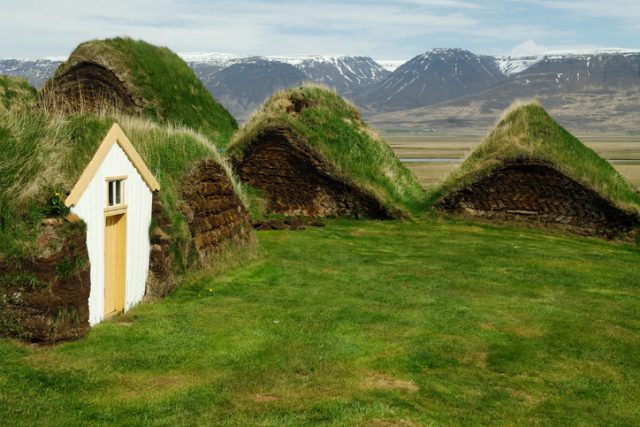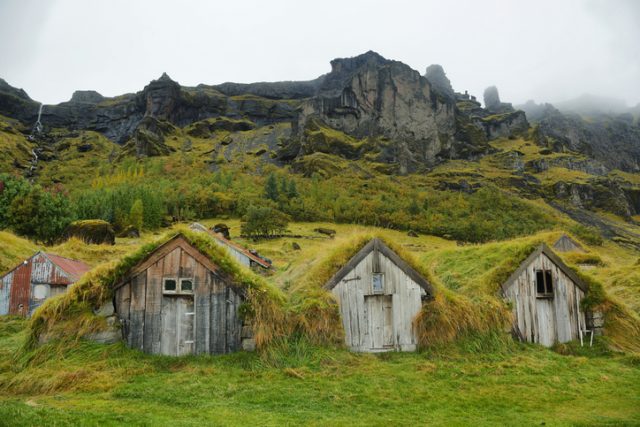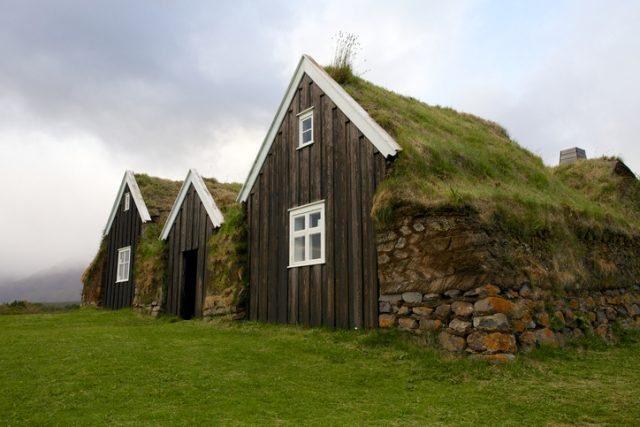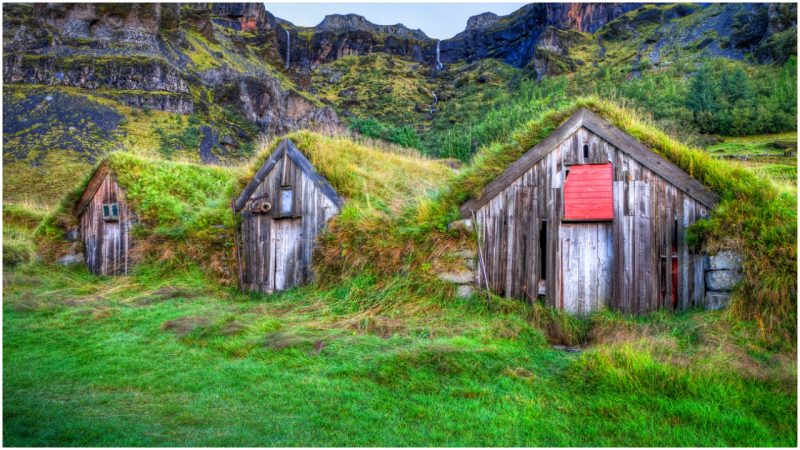Icelandic turf houses belong to a tradition that was introduced by the Vikings in the 9th century. It has then adapted to the harsh Icelandic climate, providing superior insulation. Seen today, turf houses are green-cloaked homes with grass on the roofs that are laid into the natural landscape.
Some of the techniques used to build the houses have existed since the Iron Age, but lack of evidence due to inadequate preservation raises some questions on where the influences came from. For instance, it is known that Romans used turf-building techniques for their defensive walls or fortresses once they extended to the northern parts of Europe. Examples of turf buildings can be found in many different countries, from Scotland, Ireland, Norway, Greenland, and the Faroe Islands to the Netherlands, and even some parts of the USA.
Turf houses in Iceland are special because of their unique building technique, influenced by the local climate and available materials. Since the supply of wood was extremely low, most of the timber was imported from abroad. On the other hand, lava stones and turf, the main building materials, were available in large amounts. Turf has proved to be very durable–it is both renewable and widely available. It has been taken from the wetlands in order to be properly compacted. The initial foundations are made of lava stones, which are covered with a layer of turf that is compacted, followed by alternating layers of stones and turf.

The timber structure of the house is covered with turf bricks and a roof. The grass from the roof grows over, providing the roof with further stability. These buildings, made with biodegradable materials, are eco-friendly and energy-efficient. Even the lava stones can be recycled and reused. Usually, a house can last for about 20 years, serving one generation depending on frost, after which it must undergo repairs. But sometimes turf houses can last from 50 to 70 years.
To combat their susceptibility to erosion from rain and wind, turf houses are designed in a manner to keep the heat inside. They are usually built on the side of a hill so that the living part can be completely protected and supported while the front part sticks out. They’ve consisted of a group of smaller houses or rooms that are connected by passages, so that people would not need to leave to move between dwellings and thus preserve the heat inside. Even the barns and stables are organized in the same manner and connected to the rest of the house. Since heating from coal, oil, or wood stoves was not available until the 19th century, all the warmth was provided by the fire in the kitchen. Rooms were often situated a couple of feet below the ground level, which meant below the frost line where the ground could not freeze.

Turf houses are representative of a communal way of living in which all members of the family lived and spent their time together in the same living room with the only window, where they all ate, slept, were born, and died. All the houses had the same proportions, and all people lived in the same houses regardless of class, social status, or wealth.

After World War I, a wave of modernization came close to eradicating the turf houses. Icelandic people started turning to modern buildings and using cement instead of turf. It is estimated that at the turn of the 20th century, there were more than 100,000 turf buildings, but by the 1960s there were only 234 inhabited homes in Iceland and by the 70s, most of them were deserted and almost no new ones had been built. Late urbanization in Iceland meant that villages started to grow in the 18th century and became dominant by the 20th century.
Related story from us: The loneliest house in Iceland and all the wild stories attached to it
Today, the practice of building turf houses is not widely known and mostly is being passed through new initiatives for heritage preservation. On the other hand, some of the building principles and concepts are used and modernized in contemporary architecture, and many old turf houses have been renovated or turned into museums. In the late 20th century and the 21st century, the tourist boom influenced the rise of interest and consciousness about the value of turf houses. A big step towards preserving this architectural heritage was made in the year 2011 when turf housing was nominated for UNESCO World Heritage status.
